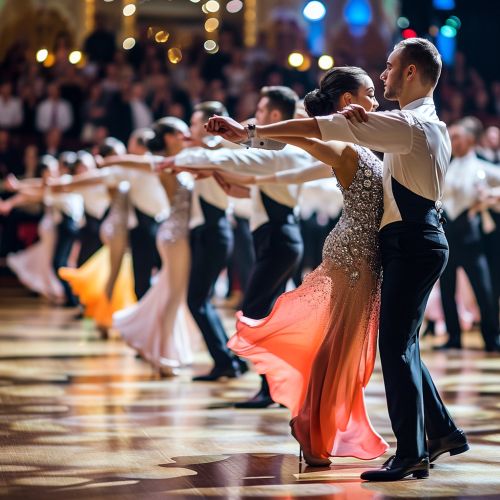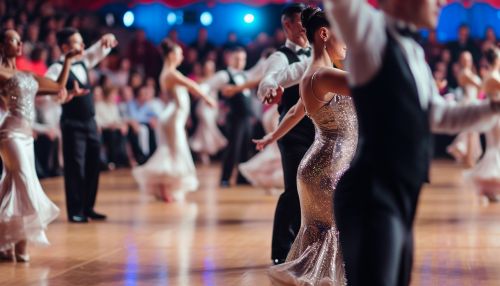Dance competition
Overview
A dance competition is a structured event in which individuals or teams perform dances in front of a panel of judges. These events are organized across various levels, from amateur to professional, and across various dance styles, such as ballroom, hip hop, ballet, and contemporary. The performances are evaluated based on a set of criteria, which may include rhythm, timing, technique, creativity, and presentation, among others.


History
The concept of competitive dance has its roots in various cultures and traditions. For instance, in many indigenous cultures, dance competitions were held as part of community celebrations or rites of passage. However, the modern format of dance competitions, as we know it today, originated in the early 20th century with the rise of ballroom dance competitions in Europe. These events were initially informal gatherings, but gradually evolved into highly structured affairs, with standardized dance styles and scoring systems.
Types of Dance Competitions
There are several types of dance competitions, classified based on various factors such as the style of dance, the age of the participants, the level of competition, and the format of the event.
Style-Based Competitions
These competitions are organized around specific dance styles. Some examples include ballroom dance competitions, hip hop dance battles, ballet competitions, and contemporary dance competitions. Each of these competitions has its own set of rules and judging criteria, which are typically aligned with the technical and aesthetic principles of the respective dance style.
Age-Based Competitions
Dance competitions often categorize participants based on their age. Common age categories include junior, youth, adult, and senior. The age divisions may vary depending on the organizing body and the nature of the competition.
Level-Based Competitions
These competitions are designed to accommodate dancers of different skill levels. The levels may range from novice or beginner, through intermediate, to advanced or professional. The level of a dancer or a team is typically determined by their training, experience, and past performance in competitions.
Format-Based Competitions
Dance competitions can also be classified based on their format. Some common formats include solo competitions, duet/trio competitions, group competitions, and formation team competitions. In addition, there are also showcase events, where dancers perform choreographed routines, and improvisation events, where dancers must spontaneously create their movements to the music.
Judging Criteria
The judging of dance competitions is a complex process that involves the assessment of various aspects of the performance. The specific criteria may vary depending on the style of dance and the rules of the competition, but some common elements include:
Technique
This refers to the dancers' execution of the movements, including their alignment, balance, and control. It also includes their ability to perform the specific techniques associated with the style of dance, such as the footwork in ballroom dance or the isolations in hip hop dance.
Musicality
This involves the dancers' interpretation of the music, including their timing, rhythm, and phrasing. It also includes their ability to express the mood and character of the music through their movements.
Presentation
This encompasses the dancers' performance quality, including their projection, expression, and stage presence. It also includes their costume and grooming, as well as their interaction with the audience and the judges.
Creativity
This pertains to the originality and artistic merit of the choreography. It also includes the dancers' ability to convey a theme or a story through their performance.
Impact on Dance Culture
Dance competitions have played a significant role in shaping the dance culture. They have provided a platform for dancers to showcase their talent, gain recognition, and advance their careers. They have also contributed to the development and popularization of various dance styles, by encouraging innovation and excellence in performance.
However, dance competitions have also been subject to criticism. Some argue that the competitive format can lead to an overemphasis on technique at the expense of artistic expression. Others express concerns about the physical and psychological pressure on the dancers, particularly on young participants.
